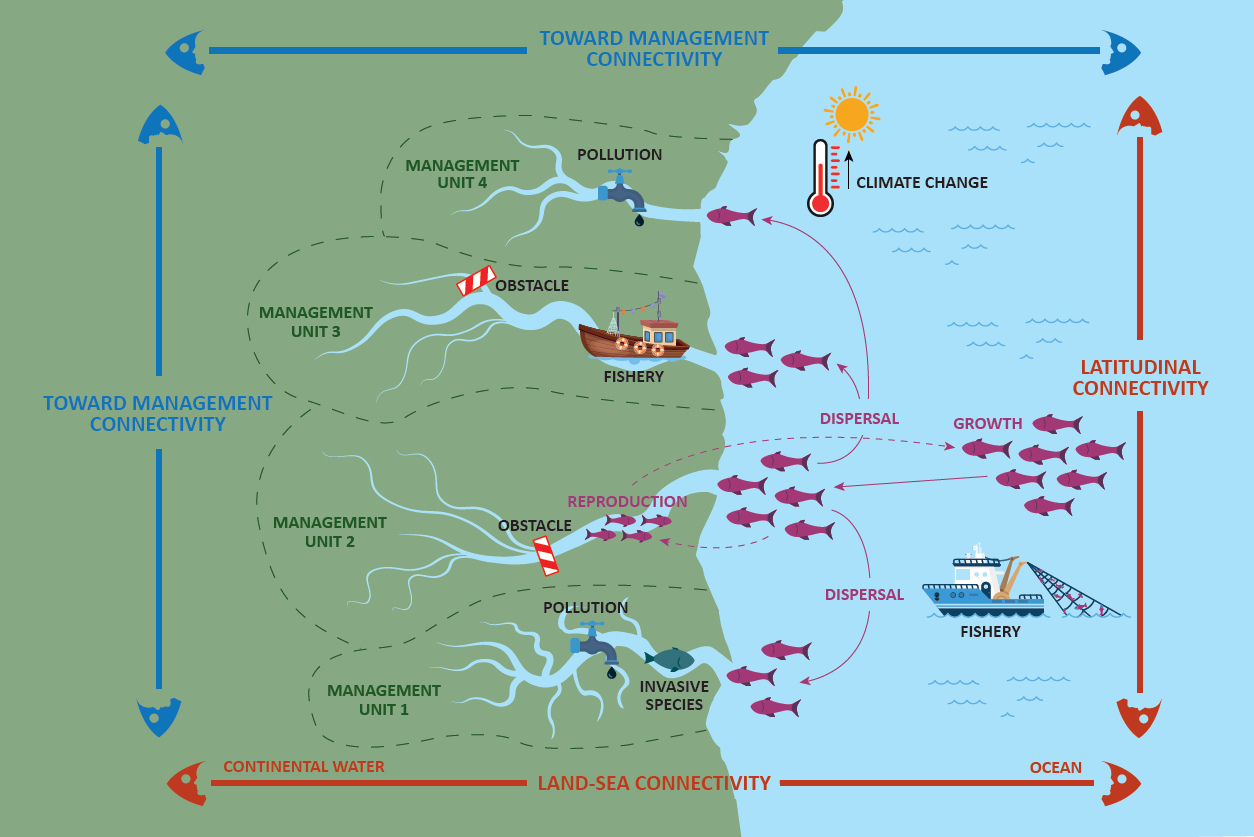Diadromous fish species (e.g. smelt, shads, lampreys, mullet, flounder, sturgeon, eel, salmon and sea trout) are migratory species connecting rivers and sea, irrespective of any administrative boundary or border. Their populations are declining across their distribution range and will inevitably endure increased pressures. Defining the basis for the long-term and large-scale management of these shared stocks becomes vital to ensure their persistence and safeguard the well-being benefits, embracing cultural, social and economic aspects, that these species deliver to local communities. With climate change driving changes in species distribution across biological and political territories, novel management approaches are needed now more than ever. The DiadES project, funded by the Interreg Atlantic Area programme, enabled cooperation across five countries, 30 partners, over four years to build the foundations of this new management. Partners proposed five key messages to positively influence necessary changes.
Key message 1. Join forces to co-produce knowledge and support sustainable management of diadromous species
Scientists, governmental agencies and stakeholders should engage in co-producing knowledge to fulfill critical research needs identified as:
- understand how fish and their habitats are connected (river to sea and reverse) and how their populations interact at different scales,
- broaden our knowledge on the value of ecosystem services including new opportunities that may arise from climate change such as a new fisheries, and
- comprehend the interactions of climate change with existing pressures such as barriers to migration and water quality issues.
However, intervention should not be postponed in face of evident declines in stocks whilst waiting for complete knowledge to be produced.
Key message 2. Optimize the use of existing international organisations and governance structures to benefit diadromous species management
A better use of intergovernmental organisations committed to conservation and management science should be used in view of their capacity to coordinate collaborative international and regional scientific work. The DiadES consortium suggested a greater focus on data-poor species (such as smelt, shads, lampreys, mullet or flounder) with scientific priority given to:
- the definition of stocks taking into account the connections between fish populations,
- the assessment of their climate vulnerability, and
- a regional-focused valuation of ecosystem services.
Ultimately, this work programme should drive full implementation of national and international nature legislations for a greater benefit for diadromous species and local communities.
Key message 3. Incorporate new dimensions to local management actions to boost diadromous species management
Local managers and related parties should define their management objectives in the context of the provisioning, cultural and regulating ecosystem services that were listed in the DiadES project along with the more traditional abundance approach. Targets should be more precautionary given uncertainties linked to climate change and cover a range of time horizons including the long-term (i.e. 10-50 years). Targets should be regularly reviewed and updated through an adaptive management process. Within the realm of ecosystem-based management, measures should promote maintenance, or in some cases, restoration, of habitats for multiple diadromous species and, very importantly, be in agreement with actions in neighbouring regions, to maximize and enhance their outcomes.
Key message 4. Share knowledge/evidence between stakeholders to reinforce diadromous species management
Managers should share management strategies, species population status, successes and failures of actions/management measures with neighbouring management units in new arenas at regional, national, transboundary and international levels. This will offer scope for joint solutions to common problems and be particularly beneficial in the case of data-poor species. The Interactive Web Atlas produced under DiadES constitutes a tool of knowledge sharing that seeks to speed up the learning process required to achieve the goal of species conservation and maintenance of the ecosystem services.
Key message 5. ‘Educate’ citizens to the culture around diadromous species
A crucial lever in actioning the reversal of the generalized decline of diadromous species is education, particularly what could be termed ‘diadromous literacy’. Better-informed and concerned citizens could increase the onus on managers to balance any competing socio-economic and environmental issues. To that end within DiadES, a serious game, ‘DiadESland’, was developed and played to raise awareness and promote discussions among a broad mix of interested parties regarding alternative management strategies for diadromous species in the context of climate change.
 Three types of connectivity around anadromous species, i.e. reproducing in rivers and growing at sea.
Three types of connectivity around anadromous species, i.e. reproducing in rivers and growing at sea.
For more information see: www.diades.eu and iwa.diades.org/

Sign up to The Parliament's weekly newsletter
Every Friday our editorial team goes behind the headlines to offer insight and analysis on the key stories driving the EU agenda. Subscribe for free here.